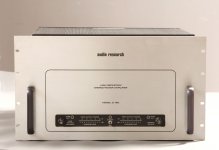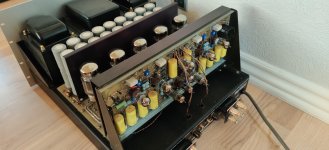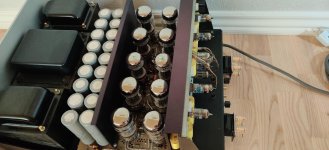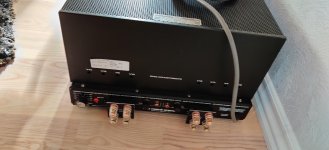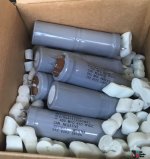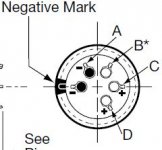Hi,
I can buy a Audio Research D160 but I can't find very much information on this AR tube amplifier.
I did consult the ARCDB pages and the Stereophile review of the D160B but that's about it.
Does anybody know more in depth about possible problems, weak points or anything else about this amplifier.
One problem seems to be those 20 Mepco/Electra Series 3187 snapin 5 pin filtercaps that are new unobtainable themselves and hard to find any good substitutes for.
Tube biasing is made easy at the back and another nice touch are the LED output meters so you see more or less the power needed to drive your speaker.
Thanks in advance,
Robert
https://www.diyaudio.com/forums/attachment.php?attachmentid=862616&stc=1&d=1595422881
https://www.diyaudio.com/forums/attachment.php?attachmentid=862620&stc=1&d=1595422881
https://www.diyaudio.com/forums/att...el-dudeks-upupa-epops-lm4780-amp-dscn0503-jpg
https://www.diyaudio.com/forums/att...862618&stc=1&d=15954228819&stc=1&d=1595422881
I can buy a Audio Research D160 but I can't find very much information on this AR tube amplifier.
I did consult the ARCDB pages and the Stereophile review of the D160B but that's about it.
Does anybody know more in depth about possible problems, weak points or anything else about this amplifier.
One problem seems to be those 20 Mepco/Electra Series 3187 snapin 5 pin filtercaps that are new unobtainable themselves and hard to find any good substitutes for.
Tube biasing is made easy at the back and another nice touch are the LED output meters so you see more or less the power needed to drive your speaker.
Thanks in advance,
Robert
https://www.diyaudio.com/forums/attachment.php?attachmentid=862616&stc=1&d=1595422881
https://www.diyaudio.com/forums/attachment.php?attachmentid=862620&stc=1&d=1595422881
https://www.diyaudio.com/forums/att...el-dudeks-upupa-epops-lm4780-amp-dscn0503-jpg
https://www.diyaudio.com/forums/att...862618&stc=1&d=15954228819&stc=1&d=1595422881
Attachments
Last edited:
Oops, what does that 5th pair of KT88's do? Do these tubes serve as screen regulators?
Best regards!
Best regards!
The way early ARC (WZJ era) amps achieve phase splitting is extremely awkward and overly complicated. Why he refused to use the cathodyne/split-load phase inverter at the input is beyond me. In fact I would even prefer to use a bridging input transformer!
The way early ARC (WZJ era) amps achieve phase splitting is extremely awkward and overly complicated. Why he refused to use the cathodyne/split-load phase inverter at the input is beyond me. In fact I would even prefer to use a bridging input transformer!
Sadly enough we can't ask Bill Johnson these things anymore.
The late J. Gordon Holt said about the D250:
"Audio Research has never been known for the simplicity of its designs, and the schematic diagrams at the back of the D-250's instruction manual are further proof that this reputation is well justified"
and
"I consider myself rather well versed in tube design topology, but there were several parts of the D-250's schematic whose functions I simply could not figure out. All I can say is that it all seems to work quite well."
and maybe answering your question (I'm not a technician so I can't question your remarks in this matter)
"Phase inversion is accomplished in an unusual manner. Instead of drawing opposite-polarity signals from the plate and cathode of a single triode stage, Audio Research simply uses an extra triode stage (padded down to unity gain) to invert polarity for the "pull" side of the circuit. This eliminates much of the imbalance between the + and the - signals, which tends to occur as the result of differing source impedances between the plate and cathode of the classic phase inverter, yielding more effective cancellation of distortion."
I wouldn't touch that ARC amp with a barge pole. It is now 20 years old and extremely complex. The more complex a device, the more that can and will fail.
Did you check out the user manual? There are eight adjustments to make in order for the unit to operate properly from the bias regulator voltage to the screen grid regulator voltage to AC and DC balance, etc. How comfortable are you working inside powered on equipment with voltages approaching 600V?
Did you check out the user manual? There are eight adjustments to make in order for the unit to operate properly from the bias regulator voltage to the screen grid regulator voltage to AC and DC balance, etc. How comfortable are you working inside powered on equipment with voltages approaching 600V?
Hi,
I can buy a Audio Research D160 but I can't find very much information on this AR tube amplifier.
I did consult the ARCDB pages and the Stereophile review of the D160B but that's about it.
Does anybody know more in depth about possible problems, weak points or anything else about this amplifier.
One problem seems to be those 20 Mepco/Electra Series 3187 snapin 5 pin filtercaps that are new unobtainable themselves and hard to find any good substitutes
Dr. Google makes it easy - how about a manual with schematics? See:
D160_Manual_Schem.pdf - Audio Research
Those Mepco caps (600 uF, 350 V) can be replaced with modern equivalents (or better) of the same diameter - I think 35 mm. I have done a similar thing for a AR D76 without much trouble.
These, for example, will probably work (under $300 for 20 for these and others are available for much less) if you mod the PS board to accept snap-in caps:
MAL225726821E3 Vishay / BC Components | Mouser
Since the per unit capacitance is higher you need fewer, and therefor could bypass the banks with large film caps.
Last edited:
I wouldn't touch that ARC amp with a barge pole. It is now 20 years old and extremely complex. The more complex a device, the more that can and will fail.
Great! That leaves more for folks who know how to work on them and appreciate them. 😀
Pretty comfortable.I wouldn't touch that ARC amp with a barge pole. It is now 20 years old and extremely complex. The more complex a device, the more that can and will fail.
Did you check out the user manual? There are eight adjustments to make in order for the unit to operate properly from the bias regulator voltage to the screen grid regulator voltage to AC and DC balance, etc. How comfortable are you working inside powered on equipment with voltages approaching 600V?
Did a complete overhaul and adjustments at my Conrad Johnson Premier One b with 516V B+
I also have a Philips Variac with a isolation transformer integrated.
Last edited:
Yes I have the manual where these schematics are included.Dr. Google makes it easy - how about a manual with schematics? See:
D160_Manual_Schem.pdf - Audio Research
And the D90 had them also I believe.Those Mepco caps (600 uF, 350 V) can be replaced with modern equivalents (or better) of the same diameter - I think 35 mm. I have done a similar thing for a AR D76 without much trouble.
I just need to find out which are the dummy pins, in other words how to connect the plus and minus pins of the snapin caps.
Thanks for the source.These, for example, will probably work (under $300 for 20 for these and others are available for much less) if you mod the PS board to accept snap-in caps:
MAL225726821E3 Vishay / BC Components | Mouser
That would be feasible and is a good tip.Since the per unit capacitance is higher you need fewer, and therefor could bypass the banks with large film caps.
The late J. Gordon Holt said about the D250:
"Phase inversion is accomplished in an unusual manner. Instead of drawing opposite-polarity signals from the plate and cathode of a single triode stage (cathodyne), Audio Research simply uses an extra triode stage (padded down to unity gain) to invert polarity for the "pull" side of the circuit. This eliminates much of the imbalance between the + and the - signals, which tends to occur as the result of differing source impedances between the plate and cathode of the classic phase inverter, yielding more effective cancellation of distortion."
J. Gordon Holt seemed to fall into the notion of the imbalance of cathodyne is due to differing impedances of cathode and plate. That has been disputed and hotly debated in other threads which anyone can search to study or challenge but it's a topic I won't get into in this thread to avoid being off topic. I can only add that of all the phase-splitters out there the ARC approach is the one I would not use. Okay, sorry for the distraction. Back to our regular program.
No, thanks for your insights in this matter.Okay, sorry for the distraction. Back to our regular program.
I asked for a educated opinion about this amp and you gave it!
Mepco/Elektra Series 3187
These are the filtercaps used in the D160(B), D90 and D76.
https://www.diyaudio.com/forums/attachment.php?attachmentid=862678&stc=1&d=1595442169
They're very strange creatures they look like that there are two lytics in one case. Then probably two leads are negative, two leads positive and one blank or dummy like this United Chemicon U91F snapin:
https://www.diyaudio.com/forums/attachment.php?attachmentid=862681&stc=1&d=1595442325
Wish I had the datasheet for this Mepco/Elektro cap
In all cases I think the minus and plus of the lytics are always in opposite (180 degrees) from eachother.
These are the filtercaps used in the D160(B), D90 and D76.
https://www.diyaudio.com/forums/attachment.php?attachmentid=862678&stc=1&d=1595442169
They're very strange creatures they look like that there are two lytics in one case. Then probably two leads are negative, two leads positive and one blank or dummy like this United Chemicon U91F snapin:
https://www.diyaudio.com/forums/attachment.php?attachmentid=862681&stc=1&d=1595442325
Wish I had the datasheet for this Mepco/Elektro cap
In all cases I think the minus and plus of the lytics are always in opposite (180 degrees) from eachother.
Attachments
I can only add that of all the phase-splitters out there the ARC approach is the one I would not use.
The ARC approach was always a fully balanced amplifier circuit. In their early models with only single ended inputs,
a single ended to balanced converter was used at the negative input (a unity gain inverting stage).
At that time, their market was not ready for balanced inputs.
When their market was ready, in their later models the converter circuit was eliminated, and their amplifiers
now had balanced input connectors. Their balanced circuit topology remained otherwise the same as always.
JGH was quite knowledgeable about amplifier circuits, and was well aware of their advantages and disadvantages,
even though he was not an engineer.
Last edited:
JGH was quite knowledgeable about amplifier circuits, and was well aware of their advantages and disadvantages, even though he was not an engineer.
Maybe. The following quote suprised me though:
"Phase inversion is accomplished in an unusual manner. Instead of drawing opposite-polarity signals from the plate and cathode of a single triode stage, Audio Research simply uses an extra triode stage (padded down to unity gain) to invert polarity for the "pull" side of the circuit. This eliminates much of the imbalance between the + and the - signals, which tends to occur as the result of differing source impedances between the plate and cathode of the classic phase inverter, yielding more effective cancellation of distortion."
What he presents as "an unusual manner" was the way to go in the period between using a transformer for phase-splitting and cathodyne or long-tail phase splitters.
And he wasn't right on top of that, 'cause his approach of an extra triode stage (padded down to unity gain) to invert polarity for the "pull" side of the circuit just turned the different source impedance matter upside down.
Best regards!
Best regards!
- Home
- Amplifiers
- Tubes / Valves
- Audio Research D160
